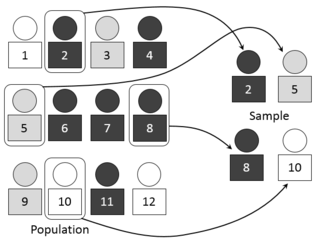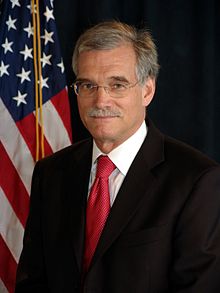In statistics, survey sampling describes the process of selecting a sample of elements from a target population to conduct a survey. The term "survey" may refer to many different types or techniques of observation. In survey sampling it most often involves a questionnaire used to measure the characteristics and/or attitudes of people. Different ways of contacting members of a sample once they have been selected is the subject of survey data collection. The purpose of sampling is to reduce the cost and/or the amount of work that it would take to survey the entire target population. A survey that measures the entire target population is called a census. A sample refers to a group or section of a population from which information is to be obtained.

The United States Census Bureau (USCB), officially the Bureau of the Census, is a principal agency of the U.S. Federal Statistical System, responsible for producing data about the American people and economy. The Census Bureau is part of the U.S. Department of Commerce and its director is appointed by the President of the United States. Currently, Rob Santos is the Director of the U.S. Census Bureau and Dr. Ron Jarmin is the Deputy Director of the U.S. Census Bureau

The Bureau of Labor Statistics (BLS) is a unit of the United States Department of Labor. It is the principal fact-finding agency for the U.S. government in the broad field of labor economics and statistics and serves as a principal agency of the U.S. Federal Statistical System. The BLS collects, processes, analyzes, and disseminates essential statistical data to the American public, the U.S. Congress, other Federal agencies, State and local governments, business, and labor representatives. The BLS also serves as a statistical resource to the United States Department of Labor, and conducts research measuring the income levels families need to maintain a satisfactory quality of life.

Sweetwater County is a county in southwestern Wyoming, United States. As of the 2020 United States Census, the population was 42,272, making it the fourth-most populous county in Wyoming. Its county seat is Green River. By area, it is the largest county in Wyoming. Its southern boundary line abuts the north lines of the states of Colorado and Utah.

Davis County is a county located in the U.S. state of Iowa. As of the 2020 census, the population was 9,110. The county seat is Bloomfield.

Georgetown is a town in Essex County, Massachusetts, United States. The population was 8,470 at the 2020 census. It was incorporated in 1838 from part of Rowley.

In statistics, quality assurance, and survey methodology, sampling is the selection of a subset or a statistical sample of individuals from within a statistical population to estimate characteristics of the whole population. The subset is meant to reflect the whole population and statisticians attempt to collect samples that are representative of the population. Sampling has lower costs and faster data collection compared to recording data from the entire population, and thus, it can provide insights in cases where it is infeasible to measure an entire population.
Survey methodology is "the study of survey methods". As a field of applied statistics concentrating on human-research surveys, survey methodology studies the sampling of individual units from a population and associated techniques of survey data collection, such as questionnaire construction and methods for improving the number and accuracy of responses to surveys. Survey methodology targets instruments or procedures that ask one or more questions that may or may not be answered.

The United States census is a census that is legally mandated by the Constitution of the United States. It takes place every ten years. The first census after the American Revolution was taken in 1790 under Secretary of State Thomas Jefferson. There have been 23 federal censuses since that time. The census includes territories of the United States. The United States Census Bureau is responsible for conducting the census.

The 2010 United States census was the 23rd United States census. National Census Day, the reference day used for the census, was April 1, 2010. The census was taken via mail-in citizen self-reporting, with enumerators serving to spot-check randomly selected neighborhoods and communities. As part of a drive to increase the count's accuracy, 635,000 temporary enumerators were hired. The population of the United States was counted as 308,745,538, a 9.7% increase from the 2000 United States Census. This was the first census in which all states recorded a population of over 500,000 people as well as the first in which all 100 largest cities recorded populations of over 200,000.
In statistics, non-sampling error is a catch-all term for the deviations of estimates from their true values that are not a function of the sample chosen, including various systematic errors and random errors that are not due to sampling. Non-sampling errors are much harder to quantify than sampling errors.
Phillip S. Kott is an American statistician. He has worked in the field of survey statistics since 1984, and is regarded as a leader in this field. His areas of expertise include survey sampling design, analysis of survey data, and calibration weighting, among other areas. He revolutionized sampling design and estimation strategies with the Agricultural Resource Management Survey, which uses survey information more efficiently. He has taught at George Mason University, and USDA Graduate School. He is currently an Associate Editor for the Journal of Official Statistics and the scientific journal Survey Methodology.
In survey sampling, Total Survey Error includes all forms of survey error including sampling variability, interviewer effects, frame errors, response bias, and non-response bias. Total Survey Error is discussed in detail in many sources including Salant and Dillman.

Edith Desiree de Leeuw is a Dutch psychologist, statistician, research methodologist, and professor in survey methodology and survey quality, at the University of Utrecht. She is known for her work in the field of survey research.
Stanley Presser, a social scientist, is a Distinguished University Professor at the University of Maryland, where he teaches in the Sociology Department and the Joint Program in Survey Methodology (JPSM). He co-founded JPSM with colleagues at the University of Michigan and Westat, Inc., and served as its first director. He has also been editor of Public Opinion Quarterly and president of the American Association for Public Opinion Research.
Nancy A. Mathiowetz is an American sociologist and statistician, known for her pioneering combination of cognitive psychology with survey methodology and for her research on poverty and disability.
Katherine Jenny Thompson is a statistician in the United States Census Bureau, where she is Methodology Director of Complex Survey Methods and Analysis Group in the Economic Statistical Methods Division.

Roderick Joseph Alexander Little is an academic statistician, whose main research contributions lie in the statistical analysis of data with missing values and the analysis of complex sample survey data. Little is Richard D. Remington Distinguished University Professor of Biostatistics in the Department of Biostatistics at the University of Michigan, where he also holds academic appointments in the Department of Statistics and the Institute for Social Research.
Timothy P. Johnson is professor emeritus of Public Policy, Management, and Analytics at University of Illinois at Chicago (UIC) and a Fellow of the American Statistical Association. His research focuses on research methods, social epidemiology, and survey methodology.
Lars Lyberg was head of research and development at Statistics Sweden, the founding editor of the Journal of Official Statistics, and a Fellow of the Royal Statistical Society and American Statistical Association. His research focused on data quality, total survey error, and research in the multinational, multiregional, and multicultural contexts. He passed away in March 2021.








